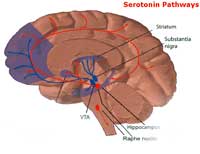A National Institutes of Health (NIH) funded study shows that electroacupuncture, “inhibits osteoarthritis-induced pain by enhancing 5-HT2A/2C [serotonin] receptor activity.” Activation of this serotonin receptor produces powerful anti-inflammatory effects. Researchers from the University of Maryland in Baltimore, MD and Shanxi Medical University in Shanxi, China showed that electroacupuncture attenuates osteoarthritis pain by activating serotonin receptors that, “play an important role in pain modulation at the spinal level.” The researchers also discovered that electroacupuncture activates serotonergic neurons that project into the spinal cord.
The study applied electroacupuncture to acupuncture points GB30 (Huantiao) and St36 (Zusanli) in rats with osteoarthritis. Thirty-two gauge acupuncture needles were inserted into the two acupuncture points on each leg with a 10Hz, 2mA, 0.4ms pulse width for 30 minutes for each acupuncture session. The results were tabulated in comparison to a sham control group. Electroacupuncture was shown to activate serotonin receptors, improve weight bearing, reduce pain, and improve joint function. The researchers note that electroacupuncture, “activated serotonergic neurons… which sends serotonergic descending fibers to the spinal cord to modulate pain…. EA [Electroacupuncture] activates different areas in the brain that, in turn, modulate various functions.” The researchers concluded that electroacupuncture has the ability to, “induce spinal serotonin release and stimulate 5-HT2A/2c [serotonin] receptor activities at the spinal cord to inhibit osteoarthritis-induced pain.”

Reference:
Serotonin Receptor 2A/C Is Involved in Electroacupuncture Inhibition of Pain in an Osteoarthritis Rat Model. Aihui Li, Yu Zhang, Lixing Lao, Jiajia Xin, Ke Ren, Brian M. Berman, and Rui-Xin Zhang. Hindawi Publishing Corporation. Evidence-Based Complementary and Alternative Medicine Volume 2011, Article ID 619650, 6 pages.

